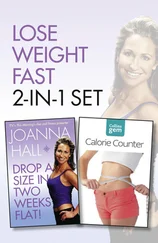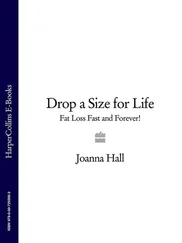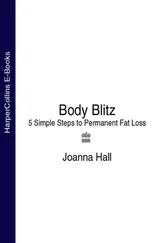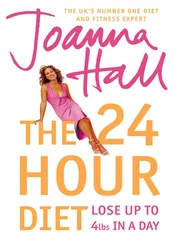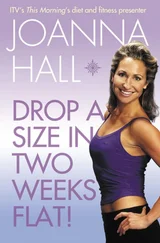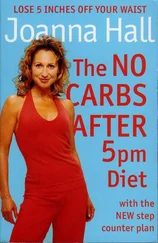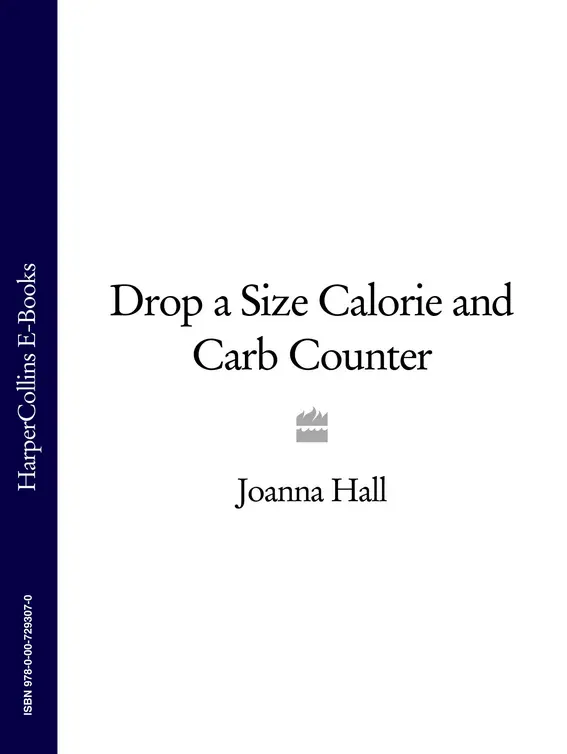
The UK's No.1 DIET and FITNESS EXPERT
Joanna Hall MSc
DROP
A SIZE
CALORIE
and
CARB
counter
How to Use this Book
Introduction
Section One - The Carb Curfew Plan
Carb Curfew - How It Came About
The Plan
Weight Loss Basics
Food Groups
Be Your Own Carb Curfew Coach
Exercise
Guide to Vitamins and Minerals
Section Two - Basic and Generic Food
Cereals and Cereal-based Foods
Biscuits (savoury and sweet)
Breads
Cakes (large)
Cakes (small)
Cereals (grains)
Cereals (packet)
Desserts (cereal-based)
Flours and starches
Pasta and noodles
Pastries (sweet and savoury)
Dairy Products
Cheese
Cream
Desserts (dairy-based)
Eggs
Milk
Sauces (dairy-based)
Spreads
Yoghurt
Fish and Seafood
Fish
Oily fish
Seafood
Fruit and Nuts
Fruit (fresh, dried and canned)
Fruit juices
Nuts and seeds
Meat, Poultry and Game
Meat
Offal
Poultry and game
Miscellaneous
Everyday store cupboard items
Drinks (alcoholic)
Vegetables and Pulses
Potatoes and potato products
Pulses, beans and lentils
Vegetables
Section Three - Brand Name Foods
Biscuits, breads, cakes and other baked goods
Cereals
Cheese, cream, milk and yoghurt
Crackers, crisps, snacks and snack bars
Desserts and ice cream
Drinks
Eating out and fast food
Fish and seafood
Meat products
Poultry products
Ready meals and side dishes
Sandwiches
Sauces, dips and dressings
Soups
Spreads
Sweets and chocolate
Vegetable products
Vegetarian foods
Other Titles by the Same Author
Copyright
About the Publisher
The Drop a Size Calorie and Carb Counter has been split into three sections to make it simple and easy to use.
Section One: The Carb Curfew Planoutlines the principles of the Carb Curfew – my easy-to-use strategy for achieving and maintaining weight loss. It also features plenty of tips and pointers on improving your health whilst you achieve your fat loss goals.
Section Two: Basic and Generic Foodsdetails not only the calorie value of basic foods, but also their protein, carbohydrate, fat, fibre and sodium contents. Included in this section are the basic ingredients of meals – for instance rice, vegetables, meat and poultry and so on – as well as store cupboard ingredients and various other everyday foods. You will find the values for both raw and cooked ingredients, so you can analyse recipes and cooking favourites. Where popular, widely available dishes are featured, such as a one-crust apple pie, the values given are averages.
Section Three: Brand Name Foodsfeatures branded foods – the supermarket favourites, specialist ranges and processed convenience foods that may be a regular feature in your shopping basket. I've included the nutritional breakdown as the standard ‘per 100 gram’ and ‘per serving’; just as you would find on food labels. Since even a basic product, like bread, can vary in the amount of carbohydrate or fat it contains, I have included a variety of different manufacturers. The nutritional value of two brands can be surprisingly different and, as consumers, we can be quite particular about our favourite brand of foods. While I have tried to include as many products as possible, there are bound to be some foods that you regularly eat that are not listed. So to help you judge for yourself how healthy these are, section one includes information on how to decipher food labels.
All the foods featured are categorized and listed alphabetically so in order to find a particular food, first decide if it a generic food such as chicken or a branded item such as Sweet Chilli Chicken Fillets by Waitrose then simply look up the relevant category from the list of contents on pages v–vii.
In total, I have detailed the overall calorie value and macronutrient content of over 5000 foods. However, while vitamins and minerals are vital components in our daily diet, I have not included the proportions of vitamins and minerals found in these foods in this book – it would simply have been too big! While they provide no direct energy to the body in the form of calories, vitamins and minerals do have a very important role to play in the health of your body. To help ensure you are getting an adequate supply of vitamins and minerals, check out the guide on page 53. This quick reference table will help you see the benefits fruits, vegetables and other foods provide for your body. It's important to bear in mind that food doesn't just provide the calories to get us through the day, but can directly affect our health, looks and energy.
The following notes will help you get the most accurate information from the book.
1 Food items listed in the Basic and Generic Foods section are listed ‘per 100g’. Sodium is listed in milligrams. All other listings are in grams.
2 Food items in the Brand Name Foods section are listed ‘per serving’ and ‘per 100g’. For each item, the figures are given ‘per serving/per 100g’. The categories are clearly given at the top of each column on every page.
3 You can find restaurant and fast food meals in Eating Out and Fast Food in Section Three. Sandwiches are listed separately in Section Three.
Abbreviations
Brand Foods:
COU = Marks & Spencer Count on Us
TTD = Sainsbury's Taste the Difference
BGTY = Sainsbury's Be Good to Yourself
GFY = Asda Good for You
In the nutritional tables:
| N = negligible |
tbsp = tablespoon |
| Tr = trace |
tsp = teaspoon |
Hello, and welcome to my Drop a Size Calorie and Carb Counter . I am always being asked about the calorie value of different foods and what the best foods are for Carb Curfew suppers – so I've put everything you need to know in one place. The idea is not to overwhelm you with lots of different figures, but to give you concise information, whether you want to lose weight or just stay within a healthy weight range.
Traditionally, calorie-counting books are used as a way of helping us monitor the amount of energy we are getting from our food and drink. To lose weight, the number of calories you eat has to be fewer than the number of calories your body burns off through exercise and your daily activities. But it's not all about numbers: eating the right type of nutrients can increase your energy levels and maximize health. Unfortunately, we often forget this in our efforts to keep weight under control and, as a result, we opt for low calorie but nutritionally poor foods. Even though your first motivation for picking up this book may be to help you count and cut calories, you'll soon find the information helps you realize your weight loss goals and improve your health, by enabling you to make wiser food choices. For example, you'll learn that energy-dense foods such as fats, and specifically saturated fats, are associated with an increased risk of heart disease, while nutritionally poor foods, such as processed, carbohydrate-rich foods that are high in sugar, can play havoc with your blood sugar levels and energy levels, and foods high in salt can affect your blood pressure.
Читать дальше




